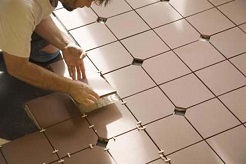Shower Tiles
If you’re planning a wet room or walk-in shower where standing water may exist, it is essential to use slip resistant tiles or mosaics.
Mosaic tiles fitting can be quite tricky though. In the ancient days of tile installation, tilers would painstakingly lay each mosaic tile individually. Fortunately mosaic tiling is much easier in today’s world. It is a matter of accurate installation. However installing hundreds of little tiles within one square foot is a recipe for crooked lines. Multiple miss-laid mosaic tiles can make your bathroom floor and wall look wonky.
A vapour barrier should be considered when applying tiles to the bathroom walls and flooring, such as aqua panel. Failing to do this, you may experience mould growth and mildew as moisture from your shower escapes through the tiles.
Tile wall weights
The maximum weight of tiling which can be supported by a dry, well-adhered plaster background is 20kg/m². This is equivalent to ceramic tiles with a maximum thickness of 8mm plus tile adhesive or natural stone tiles with a maximum thickness of 7mm plus tile adhesive
The weight of tiling to a plasterboard background direct (without plaster skim) should not exceed 32kg/m². This is equivalent to a ceramic tile and adhesive with a maximum thickness of 12.5mm and natural stone and adhesive with a maximum thickness of 10mm.
It is important to emphasise that the weights quoted includes both the tile and adhesive.
Why use tiles?
Ceramic and natural stone tiles used to be confined just to the bathroom and kitchen. Now UK homeowners are becoming more like their European neighbours and are using tiles throughout the home.
Go for the latest porcelain, natural stone in trendy pale beige or cream. They provide a neutral background to the rest of your furnishings and are extremely robust and hardwearing. Ring the seasonal changes with colourful rugs Cool pastels for the summer and deep reds and golds for the winter. You can even tile outside as many tiles are frost resistant; but do check. Tile the floors both sides of the patio doors with the same tile and watch as the dining room passes almost imperceptibly into the garden.
In kitchens ceramic tile is ideal on floors, walls, splash backs and work tops. Fat, grease and food spills are just wiped away and dirty footprints from pets and children are no problem. For extra hygiene and assurance you can use a grout with antibacterial protection and you can use bleach and strong cleaners on a glazed ceramic floor with no risk of long term damage.
Bathroom tiles
In bathrooms tiles are clean and hygienic on walls and floors. We all know how careless children and some grown ups can be about water in the bathroom. With ceramic tiles you no longer need to worry; whether it’s from little drips or big drips liquids can just be wiped up. Why not turn your bathroom into a wet room or add a walk in shower. There are kits available for tanking (waterproofing) the walls and floors so that the water stays in the bathroom. With the latest adhesive technology, you can tile on suspended wooden floors so give that bathroom a face lift; and while you are doing that why not treat yourself to a bit of extra luxury and have undertile heating installed? You’ll get the bonus of extra wall space where radiators are no longer needed. The systems are so thin they are easy to install and relatively inexpensive.
Under floor Tile heating
Underfloor heating could be the solution for you. As well as an absolute treat for you feet during the cold winter mornings, it’s a great space-saver as well as an energy-efficient way to warm up your household. Heat-up time depends on the thickness of the tiles. Thick flagstones will take longer to reach optimum temperature, but once this is reached there’s no difference in heat quality between thick or thinner floor surfaces.
Floor Tiles
Ceramic, quarry and natural stone tiles such as porcelain, marble, granite and travertine, make an attractive floor covering in kitchens, bathrooms, hallways, living rooms or conservatories, and they are easy to care for and hardwearing.
Laying the foundation is your first port of call. What is your original floor made of? Plywood is good but needs to be thicker enough not allow the tiles to buckle under weight. We can give you advise how to prepare your flooring before we lay floor tiles.
With Porcelain tiles you need to use a flexi adhesive and a flexi grout. and the tiles need to be sealed to protect from spillages.
Natural tiles such as marble, granite, travertine, slate or limestone require special care. These tiles normally require ceiling twice to protect from unwanted staines and ageing. Natural tiles need to be fitted with a flexi adhesive and a flexi grout. If you choose a limestone tile a white adhesive must be applied to ensure that the adhesive does not show through the tile. A grey adhesive should be used for slate tiles and dark floor tiles.
to book a FREE quote










